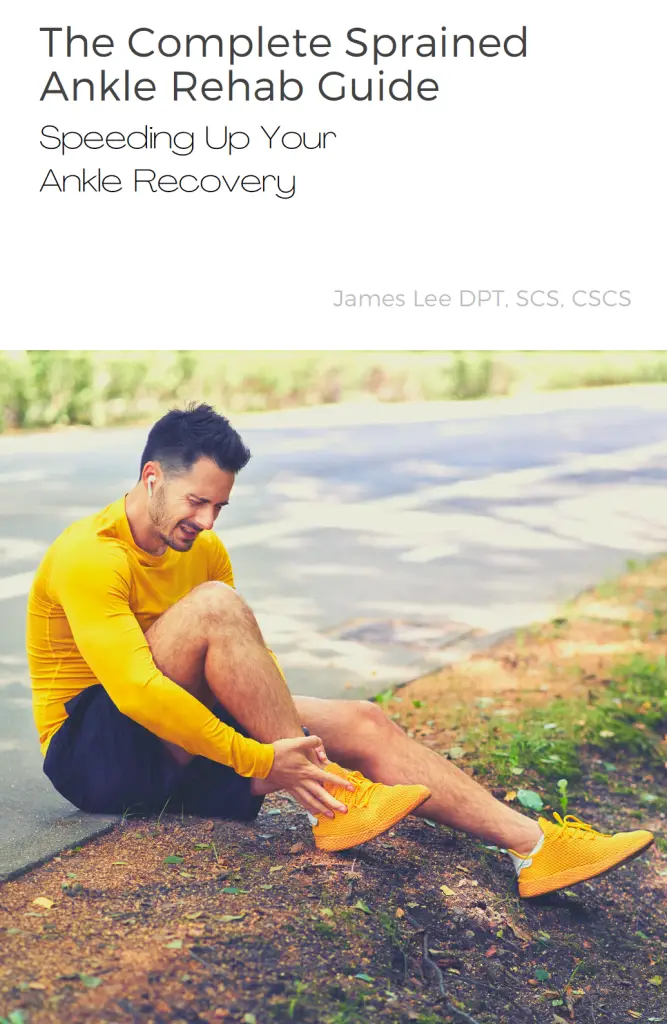Welcome to the complete sprained ankle rehab guide! Congratulations on taking the necessary steps to treat and make a full recovery from your current or any previous ankle sprain.
In this guide, you’ll find tons of helpful content. We cover everything from the basics to complex return to sport exercises. With 77 pages of content and 13 chapters, we cover any and all questions you might have regarding a sprained ankle.

The guide starts with a comprehensive education to help you better understand what you’re going through.
Next, the guide goes into when to see a doctor and if necessary.
This leads to what types of treatments work and what don’t typically work. We’ll guide you through how to speed up recovery in the early phases of the injury.
Finally, the part everyone is interested most in; we go over in detail with links to videos about exercises and when to do the exercises.
We have great tips, helpful links, and many other great resources to ensure that you make a full recovery.
Why You Should Download This Guide
If you are hesitant to download this guide, let me help you consider why this guide is a must-buy.
- It saves you money
- It saves you time
- It helps prevents any long-term damage
- It helps make a complete recovery
Saving You Money
How will the guide save you money? Through multiple ways. This complete ankle sprain guide will help educate you on when you need to an-x-ray (rarely) and an MRI (almost never), saving you money on expensive tests.
It also goes into detail about when to see the Doctor (less than you think) and helps you find affordable ankle braces and walking boots that don’t cost an arm a leg through insurance.
Saving you Time
This guide will save you time in two main ways.
First, you can start your recovery immediately, saving you precious time. The sooner you start the rehab process, the sooner you will return to normal.
Secondly, we save you the headache and time you would be waiting to get into a Doctor who would then refer you to Physical Therapy. While you’re waiting for these appointments, you could be well on your way to healing.
Preventing Long-Term Damage
Most people who sustain an ankle sprain employ the wait-and-see approach. They wait and see how good it will be and are really unsure of what to do and when.
This guide will guide you on the WHAT exact exercises you should be doing and WHEN to do them. This avoids complications of doing too much to cause more damage or too little and risking not recovering fully.
If you don’t make a full recovery, this leaves you at risk of considerably worse ankle sprains.
Make a Complete Recovery
Making a complete recovery is more important than most realize. The problem with ankle sprains is that they leave you susceptible to a worse condition called Chronic Ankle Instability (CAI).
Chronic ankle instability is a condition that occurs when you don’t make a full recovery from an ankle sprain and leaves you at risk of sustaining multiple sprains in the future.
This can lead to quicker development of arthritis and other orthopedic injuries.
It’s important that you take of even the small and mild ankle sprains to make a full and complete recovery so that you don’t risk developing worse conditions.
Table of contents
Here is the table of contents so you can see all the covered topics
- Introduction to Sprained Ankles
- What is a Sprained Ankle
- Why Is Rehab For a Sprained Ankle Important?
- Are All Ankles Sprains the Same? Understanding the Different Grades
- Prognosis: How Long Does an Ankle Sprain Take to Heel
- When to See a Doctor
- Ankle Brace: Do You Need One?
- Initial Treatment – What to do in the First 72 Hours
- Phase 1 Exercises: Get Moving
- Phase 2 Exercises: Walking Normal
- Phase 3 Exercises: Getting Back to Normal
- Returning to Sports: When is the Right Time
- Frequently Asked Questions
- About the Author
- Helpful Links and Resources
About the Author
James C. Lee DPT, SCS, CSCS
James is a native of Limestone, TN. He attended the University of Tennessee, where he received his BS in Health and Exercise Science and completed his Doctorate of Physical Therapy from the University of Saint Augustine.
James worked as a traveling physical therapist and treats various patients with a specialty in Orthopedics and Sports Medicine. James is a board-certified Sports Physical Therapist, and a Strength and Conditioning Specialist, and is certified in Functional Dry Needling, Running Gait Analysis, and Blood Flow Restriction Therapy.
James contributes his expertise to physical therapy websites, including physicaltherapyproductreviews.com and other guest appearances.
Disclaimer: The information provided in this post is for educational purposes only. This is not a substitute for a medical appointment. Please refer to your physician before starting any exercise program.